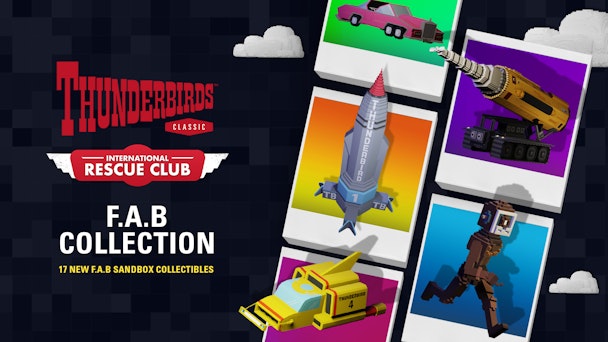As Disney pulls out, why are brands still investing in the metaverse?
While the great metaverse gold rush is over, brands are still creating experiences on platforms including Sandbox and Fortnite. What do they hope to achieve?

ITV Studios’ Thunderbirds experience exceeded its expectations – but what are the KPIs for other metaverse executions? / ITV Studios
The hype around the metaverse has been supplanted by AI. Disney, in a cost-saving measure, has sloughed off its entire metaverse department. But despite the rapid shift in priorities, brands including Heinz, ITV, Royal Caribbean and more are continuing to invest in creating metaverse experiences.
While early builds by luxury brands like Nike and Gucci focused upon the money-making opportunity of metaverse e-commerce, these new experiences seem to be just that – an experience for the players. Why, then, are brands committing to spend on metaverse platforms when there is no direct revenue model?
Given the relative nascency of the metaverse as a marketing platform, some brands are still in the experimentation phase. The perception is that users of platforms like Fortnite Creative and Roblox are skewing younger, providing those brands with a way to create familiarity with brand-new audiences.
Metaverse is GO
Leila Ahmed is brand manager for ITV. In partnership with Reality+, the TV brand launched a Thunderbirds branded experience on Sandbox, which over its first two weeks attracted 25,000 unique visitors and 40,000 visitors in total. She explains: “One of our main goals is just really to try to engage and reach new audiences. With the existing IPs that we have, we want to just offer a new way for our fans to engage, because I think everyone is so used to the traditional TV linear space. We also want to keep them engaged, but at the same time attract a whole new audience by doing these kinds of new activations.”
Sean Graham is product owner for Reality+. He notes that revenue through digital collectibles is possible when the IP is strong: “They’ve proven popular, they sold out very quickly, the secondary markets are healthy. There's not necessarily immediate value other than having digital collectible items for things like that.” He also states that interoperability – one of the key requirements for metaverse e-commerce to take off – is set to arrive more fully in 2023.
Kara Wallace, SVP and chief marketing officer, Royal Caribbean International, also noted that direct revenue is hard to achieve, especially for true luxury products. However, she said: "We want to show up in unexpected ways, across new territories in a way that reaches families where they are spending time. Younger travelers are playing a big role in choosing holiday plans.
Tom Ffiske is a metaverse and web3 analyst for the Immersive Wire. He explains that the brand uplift that comes from executions on there is worth the investment, which is minimal on self-serve platforms like Fortnite Creative and Roblox:
“The predominant benefit is PR/brand awareness, penetrating a new demographic to increase pick-up for a brand. For example, Roblox has a young player base that many companies want to get in front of. To do it successfully, they create experiences that match the ethos and benefits of the platform itself, then funnel people towards their products or services.”
He notes, too, that the relative newness of the metaverse makes especially sophisticated measurement of campaign effectiveness difficult. That necessitates a focus on brand awareness metrics.
The metaverse is gaming
Some brands, by contrast, are investing in the platforms purely because of those game-like attributes.
For Oreo, which still sees itself as a challenger brand in the UK, the opportunity comes from speaking to younger communities on platforms most relevant to them. Rafael Espesani is its senior brand marketing manager. He explains: “There's a lot of talks around [the] metaverse, which is just a new label. If you try to decipher what is behind it, a lot of talks are actually around gaming. We want to leverage the power to connect with a different audience through gaming and all the endless possibilities it brings with it.”
He states that the core KPI is around creating ‘brand love’. Given that Oreo is trying to succeed in a market that is saturated by well-known heritage brands, its approach is to embed itself in communities in gaming and metaverse platforms, to reach audiences who are not necessarily reached by those other brands.
Similarly, Heinz recently launched its own branded experience in Fortnite Creative. Cristina Kenz is chief growth and sustainability officer for Heinz. She explains that the interactivity of the metaverse platform is what ultimately led them to choose it, as it furthered the awareness of its ongoing sustainability campaign in a way that other mediums cannot:
“We chose to work on this experience as a key feature of Fortnite gameplay is the progressively shrinking island. So, knowing that we wanted to shine a light on the rapid rate at which the world’s soil health is declining – while also exciting gamers to play – what better way than to make our island that shrinks even quicker than usual? 33% quicker to be exact.”
She also states that the company has done similar executions in games like Call of Duty, with limited-time modes, suggesting the brand sees the metaverse as an extension of its gaming marketing experiments.
So while the sheen has come off the metaverse in general, there are still tangible benefits for brands looking to create experiences on the platforms. Whether that’s the additive revenue of selling digital reproductions or creating brand uplift, there are still incentives for brands to enter the metaverse.

